Contenu
En tant que spécialiste du marketing d'affiliation, vous êtes toujours à la recherche de nouveaux types de contenu à produire. Un contenu qui soit à la fois utile à vos lecteurs et susceptible de générer des revenus d'affiliation par le biais de recommandations.
Introduction : le format Listicle. La rédaction d'articles de type "listicle" est un excellent moyen de tirer parti de la notoriété de la marque d'un concurrent et de vous mettre en contact avec des personnes prêtes à acheter.
Dans ce billet, nous aborderons les tenants et les aboutissants de la rédaction d'un article, notamment :
- Qu'est-ce qu'un article ?
- Pourquoi la rédaction d'articles "alternatifs" fonctionne-t-elle pour le marketing d'affiliation ?
- Comment rédiger un article sur les alternatives en 4 étapes.
- Comment trouver des mots-clés alternatifs à cibler.
À la fin de cet article, nous fournirons également 6 exemples d'articles alternatifs sur les marchés des logiciels et des produits physiques. Sans plus attendre, commençons !
Qu'est-ce qu'un article sur les alternatives ??
En bref, un article de liste est un article de blog qui utilise un format de liste. En outre, un alternatives La listicle est utilisée pour suggérer d'autres options et solutions.
Supposons, par exemple, que vous aimiez les montres. Vous rêvez de posséder un jour une Rolex Submariner. Mais comme elles sont très chères, vous cherchez des "alternatives à la Rolex Submariner" pour trouver des montres similaires, mais moins chères.

Ce phénomène est très courant pour les produits physiques et les marques, ainsi que pour les logiciels. En outre, plus le produit est populaire, plus la demande d'alternatives est importante.
Ces types de mots-clés représentent une grande opportunité pour votre optimisation des moteurs de recherche (SEO) et la stratégie de contenu.
Pourquoi l'écriture de listicles alternatifs fonctionne-t-elle pour le marketing d'affiliation ?
Pour les spécialistes du marketing d'affiliation, les mots-clés alternatifs sont une mine d'or. Il s'agit de mots-clés à forte intention.
Lorsque quelqu'un cherche une "alternative", il se trouve au bas de l'entonnoir. Il connaît son problème ou son désir, a commencé ses recherches et connaît certaines des solutions. Il est très probable qu'il ait découvert les leaders du marché, mais qu'ils ne lui conviennent pas tout à fait.
Ils sont prêts à acheter s'ils peuvent trouver la bonne alternative.
Vous le verrez le plus souvent avec les produits, les marques et même les catégories. Par "catégorie", nous entendons quelque chose comme "kettlebell alternatives" (pas un produit ou une marque spécifique, mais une indication de la solution recherchée).
Voici d'autres exemples de recherche :
- Produits logiciels: Alternatives Trello, Alternatives Mailchimp, Alternatives Netflix
- Produits physiques: alternative à l'iPad, alternatives à la GoPro
- Marques: Alternatives Rolex, Alternatives Under Armour
- Catégories: alternatives aux kettlebells, alternatives au sucre pour la pâtisserie
Tout comme pour le marketing d'affiliation, cette stratégie de contenu SEO fonctionne très bien pour les marques concurrentes. Les nouveaux produits peuvent tirer parti de la notoriété de leurs concurrents plus importants en se positionnant comme une alternative.
Comment rédiger un article sur les alternatives en 4 étapes
Se classer pour un mot-clé alternatif n'est plus aussi facile qu'avant. Il y a 5 à 10 ans, vous pouviez lancer aveuglément une liste de solutions, copier et coller les caractéristiques de la page de vente du vendeur, optimiser le titre de votre page et vous attendre à être classé premier.
À l'exception des niches à très, très faible concurrence, cela ne suffit plus aujourd'hui. D'autant plus que les Mise à jour de Google sur les évaluations de produits en avril 2021, il est plus important que jamais d'apporter une réelle valeur ajoutée à votre public.
Au lieu de dresser une liste de produits au hasard, vous devrez réfléchir aux différents cas d'utilisation. Ensuite, vous devrez rédiger des raisons pertinentes pour lesquelles chaque produit serait le mieux adapté à chaque situation.
Voici 4 étapes simples à suivre pour rédiger un article percutant et efficace.
1. Identifier les points forts du produit
La première étape consiste à comprendre ce qui rend un produit attrayant. Vous devez vous concentrer sur les les spécificités d'un produit et comment les gens fondent leur recherche d'alternatives.
Par exemple, il y a généralement une raison particulière pour laquelle quelqu'un choisit de chercher des "alternatives à Trello", plutôt qu'un "logiciel de tableau Kanban" ou des "outils de gestion des tâches". Peut-être que Trello offre un certain nombre de points forts que cette personne recherche, c'est-à-dire.. :
- Une version gratuite généreuse
- Gestion des tâches de type Trello
- Une interface simple
Pour une raison ou une autre, dans ce scénario, Trello ne convient tout simplement pas au consommateur. Cela nous amène à l'étape suivante : comprendre pourquoi.
2. Identifier les raisons de rechercher une alternative
La deuxième étape consiste à déterminer pourquoi quelqu'un chercherait une alternative, ce qui implique généralement de rechercher les inconvénients ou les limites d'un produit.
Parfois, le mot-clé est explicite. Au lieu de taper "Mailchimp alternatives", quelqu'un pourrait chercher "Mailchimp alternatives moins chères". Dans ce cas, cette étape est redondante, et vous connaissez déjà la motivation : le coût.
En général, nous ne connaissons pas les motivations. La recherche est simplement produit sans contexte supplémentaire, nous devons donc couvrir nos bases.
Cela rendra votre article plus utile, plus susceptible d'être classé, et il se convertira mieux si un lecteur peut trouver la solution parfaite pour son cas d'utilisation. Pour commencer, voici quelques inconvénients courants que vous pourriez identifier :

3. Rechercher des produits dans le créneau qui corrigent chaque inconvénient
Pour chacun des inconvénients potentiels, il vous appartient maintenant de proposer une alternative. En poursuivant sur le thème des alternatives de Trello, vous pourriez suggérer quelque chose pour des cas d'utilisation comme :
- Un outil plus adapté à une niche spécifique (par exemple, plus adapté aux développeurs ou aux concepteurs)
- Un prix de départ plus bas pour les plans payants
- Des logiciels plus performants pour la planification des ressources/capacités
Et ainsi de suite.
Vous pouvez ensuite énumérer les suggestions et les clarifier qui et ce que La meilleure façon de présenter chaque produit est de le résumer brièvement. Il est courant de faire ressortir les principaux détails et caractéristiques de chaque produit, mais assurez-vous que ce n'est pas le cas. tous que vous faites. N'oubliez pas d'ajouter de la valeur à ce que les utilisateurs peuvent déjà trouver sur le site web de la marque.
Voici quelques idées :
- Renvoyez-le au produit d'origine. Si vous optez pour cette suggestion (par exemple, Asana comme alternative à Trello), que perdrez-vous ? Que gagnerez-vous ?
- Commenter l'historique de l'amélioration du produit. Des mises à jour ou de nouveaux modèles ont-ils été publiés récemment ?
- Quels sont les autres facteurs clés de décision ? Par exemple, si vous écrivez sur les couteaux de cuisine : quel acier est utilisé, et qu'est-ce que cela signifie pour l'utilisateur ? Sont-ils faciles à aiguiser et à entretenir ? etc.
4. Fournir une version courte
Au début comme à la fin d'un article, il est utile de donner un bref aperçu. Voici quelques exemples de différents types de résumés de produits :
Les bases absolues
Pour cette méthode de synthèse, il suffit de noter les critères selon lesquels chaque produit est la meilleure alternative et le nom du produit :
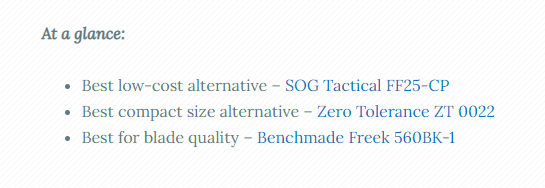
Vous pouvez l'ajouter au début d'un article en quelques secondes.
Texte en clair avec de courts résumés par produit
Avec ce type de résumé, vous devrez fournir un peu plus d'informations, tout en visant le minimum de détails dont un lecteur pourrait avoir besoin pour prendre sa décision. Vous pouvez également configurer votre article de manière à ce que les lecteurs puissent soit cliquer maintenant, soit choisir de faire défiler l'article vers le bas pour obtenir plus de détails :
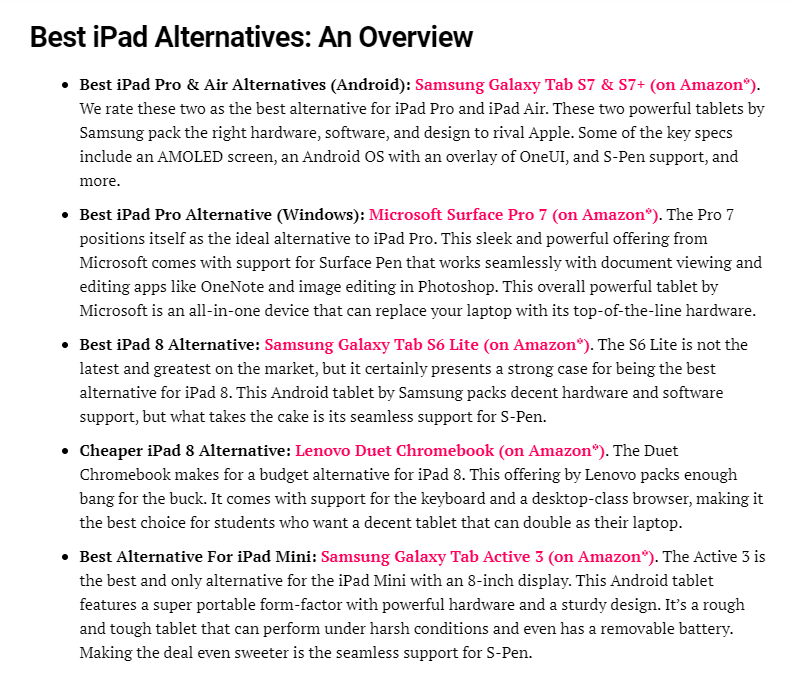
Même si les sections de texte sont plus grandes, il s'agit d'une méthode très rapide et facile à mettre en œuvre en tête de votre article.
Une vue d'ensemble Tableau
Ce style de résumé est très visible et nécessitera probablement l'utilisation d'un plugin ou d'un logiciel. Toutefois, le travail de préparation supplémentaire en vaut la peine, car les tableaux et les graphiques entraînent souvent des taux de conversion plus élevés.
Il s'agit d'un moyen rapide et visible de présenter les alternatives avec une vue d'ensemble de leurs caractéristiques :
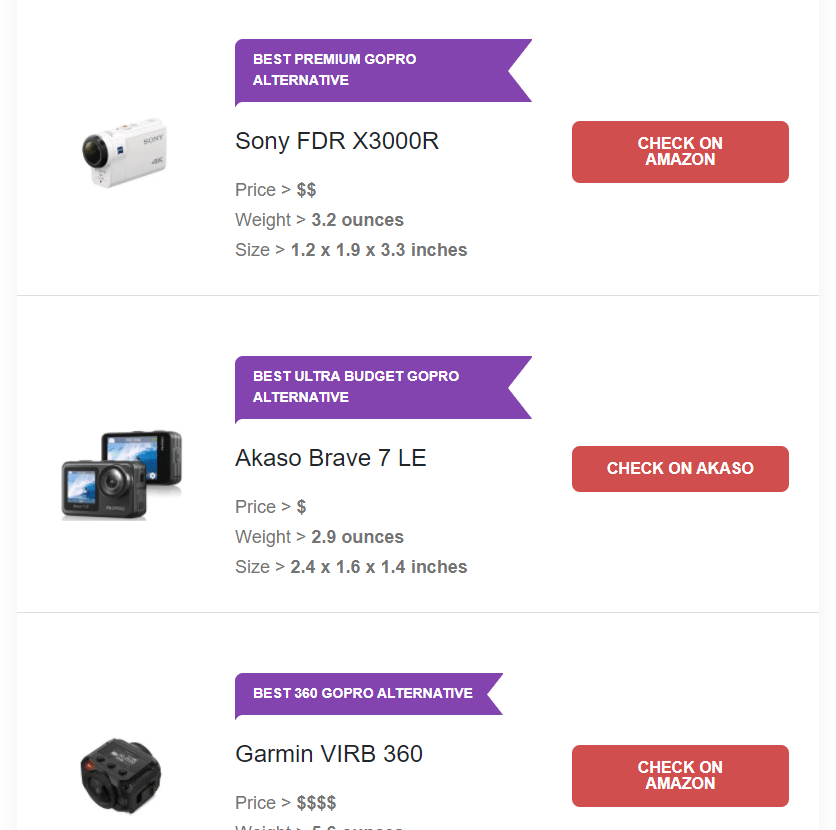
En plaçant un tableau au début de votre article, de nombreux lecteurs ne liront même pas l'article lui-même. Si vous mettez en évidence les principales alternatives dès le début (au-dessus du pli), vous obtiendrez probablement plus de clics et moins de rebonds.
Moosend Une version plus détaillée de cette question est disponible dans le site web de la Commission européenne, à l'adresse suivante Alternatives à Mailchimp avec un guide PDF cliquable résumant les options :
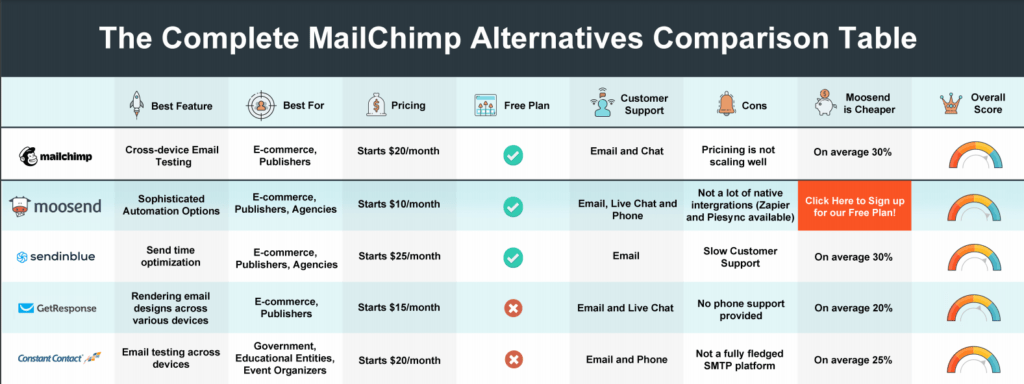
Essayez de mettre en œuvre cette méthode sommaire et vérifiez par vous-même si le taux de clics (CTR) de votre lien d'affiliation augmente.
Comment trouver des mots-clés alternatifs à cibler
Voyons maintenant comment vous pouvez trouver des opportunités "alternatives" pour votre niche.
Tout d'abord, vous aurez besoin d'un outil de recherche de mots-clés. Pour les exemples de cet article, nous utiliserons l'un de nos favoris, KWFinder de MangoolsIl s'agit d'un outil très efficace pour trouver des mots-clés à faible volume.
Pour commencer, deux stratégies principales s'offrent à vous : la recherche par mot-clé ou l'analyse des domaines concurrents.
Recherche par mot-clé
La recherche par mot-clé est exactement ce qu'elle semble être. Avec cette stratégie, vous passez en revue vos idées initiales en effectuant une recherche par mot-clé.
Par exemple, disons que vous êtes dans la rubrique marketing par courrier électronique de l'espace. Vous pouvez commencer par Mailchimp, l'une des marques les plus connues dans ce domaine.
En utilisant le KWFinder de Mangools, vous pouvez taper "Mailchimp alternatives" pour voir le volume de recherche moyen par mois, ainsi que les tendances dans le temps, et même obtenir un aperçu de la SERP actuelle :

Vous trouverez également les variantes de longue traîne qui font l'objet d'une forte demande de recherche (s'il y en a).
Dans ce cas, nous avons des mots-clés comme "meilleures alternatives Mailchimp", ainsi que "alternatives Mailchimp moins chères", et "alternatives Mailchimp open source" :
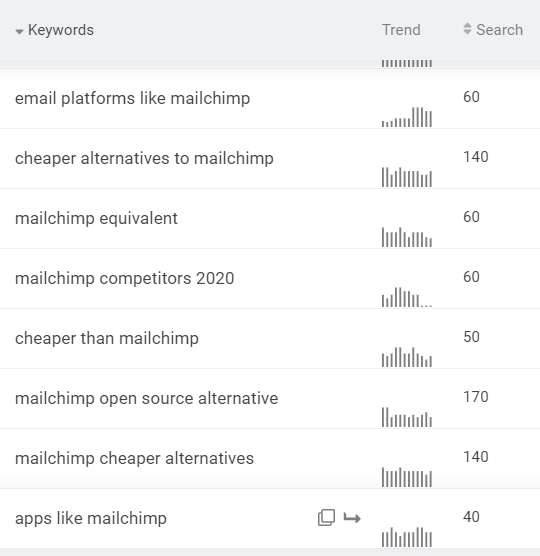
À partir de là, vous pouvez choisir de créer du contenu pour un mot-clé ayant un potentiel plus élevé, mais aussi une plus grande difficulté (Mailchimp alternatives). Vous pouvez également choisir l'une des alternatives à faible potentiel pour laquelle il serait plus facile de se classer, par exemple "Mailchimp open source alternative".
L'utilisation d'un mot-clé de marque est particulièrement efficace dans le cadre de cette stratégie. Il suffit de rechercher le nom de la marque et d'ajouter "alternatives" pour obtenir un grand nombre d'idées de contenu.

La recherche "Rolex alternatives", par exemple, nous donne une longue liste de mots-clés apparentés. Il s'agit d'idées d'articles pour des modèles Rolex spécifiques, classés par ordre de volume de recherche.
Recherche par domaine concurrentiel
Une deuxième option consiste à faire de la rétro-ingénierie sur ce qui fonctionne bien chez vos concurrents.
Cela peut s'avérer très utile pour trouver de nouvelles idées auxquelles vous n'auriez pas pensé auparavant, mais à condition que vous soyez assuré d'avoir au moins certains concurrence.
Commencez par introduire un domaine concurrent dans votre outil de recherche de mots-clés. Vous obtiendrez une longue liste de tous les mots-clés pour lesquels le domaine ou l'URL est classé. Vous pouvez ensuite filtrer cette liste pour n'inclure que les mots-clés contenant le terme "alternatif".
Voici ce que cela donne dans KWFinder :
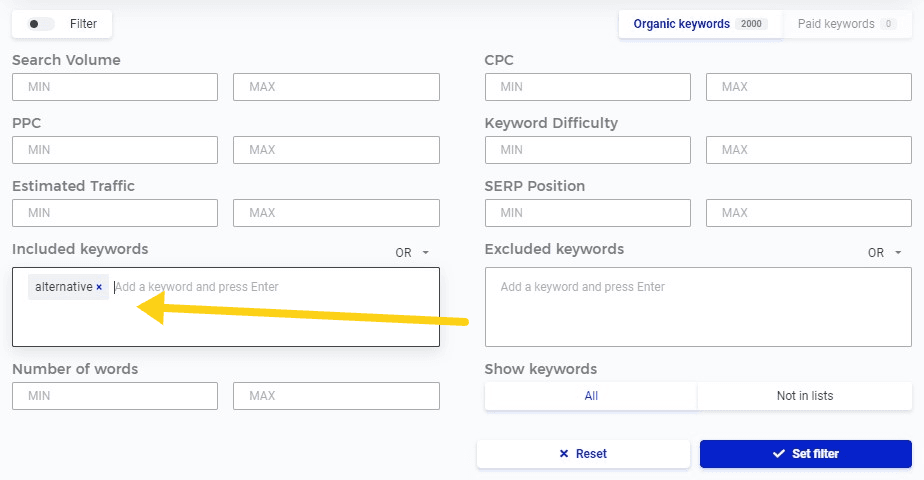
Vous obtiendrez ainsi une liste de mots-clés pour lesquels le domaine est classé et qui contiennent le mot "alternatif" :
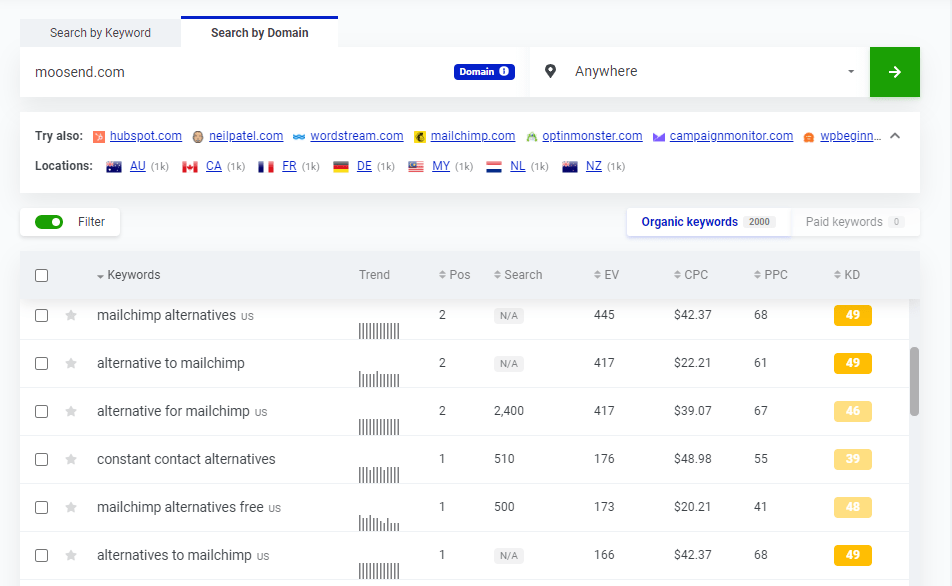
Conseil bonus : Vérifier les données de votre Google Search Console
Enfin, voici un exercice de mots-clés intéressant que vous pouvez réaliser sans logiciel tiers. Sachez qu'il ne fonctionnera pas pour les nouveaux sites, mais si vous publiez du contenu depuis un certain temps, il vaut la peine d'y jeter un coup d'œil.
Google Search Console est un service gratuit qui peut vous aider à surveiller, maintenir et résoudre les problèmes de visibilité de votre site dans Google. Après avoir créé un compte et ajoutez la propriété de votre site webvous pouvez obtenir un accès instantané à cette puissante fonctionnalité de mots-clés.
Ouvrez votre rapport de performance dans Search Console et ajoutez un filtre pour les requêtes contenant "alternative" :

Il est courant de voir des sites qui ont obtenu des impressions par inadvertance pour des mots-clés qu'ils n'auraient jamais pensé à rechercher autrement.
Cela étant dit, vous pouvez également constater que cette méthode permet de trouver des mots-clés que d'autres outils de recherche n'ont pas trouvés. Il s'agit là d'une excellente opportunité, car si vos concurrents utilisent les mêmes outils de référencement, ils ne les auraient pas trouvés non plus !
Une fois que vous avez terminé, vous pouvez facilement organiser ces opportunités en un seul endroit à l'aide d'une feuille Google, logiciel de cartographie mentaleun outil de gestion des tâches - tout ce qui vous convient.
La dernière chose à faire est d'évaluer la difficulté des mots-clés et de décider quels mots-clés sont prioritaires. Ne vous fiez pas uniquement à la mesure de la difficulté des mots-clés. analyser le profil des liens retour (backlink) des pages de classement actuelles.
Quelques conseils utiles à garder à l'esprit :
- Plus le volume de recherche est important, plus le classement sera difficile.
- Si vous êtes sur un domaine relativement nouveau sans beaucoup de liens retour, essayez de trouver des mots-clés à très faible concurrence pour obtenir une certaine traction avec en premier lieu.
6 Alternatives Listicle Exemples
Après tout cela, nous allons maintenant vous montrer 6 exemples concrets que vous pouvez consulter avant de commencer votre propre article. Ces exemples sont répartis en 3 exemples de produits SaaS et 3 exemples de produits physiques.
Articles sur les alternatives au SaaS
1. Ahrefs Alternatives par Marketing Arsenal
Dans cet article d'affiliation, les raisons les plus courantes de rechercher des alternatives à Ahrefs ont été identifiées autour du prix et des fonctionnalités :
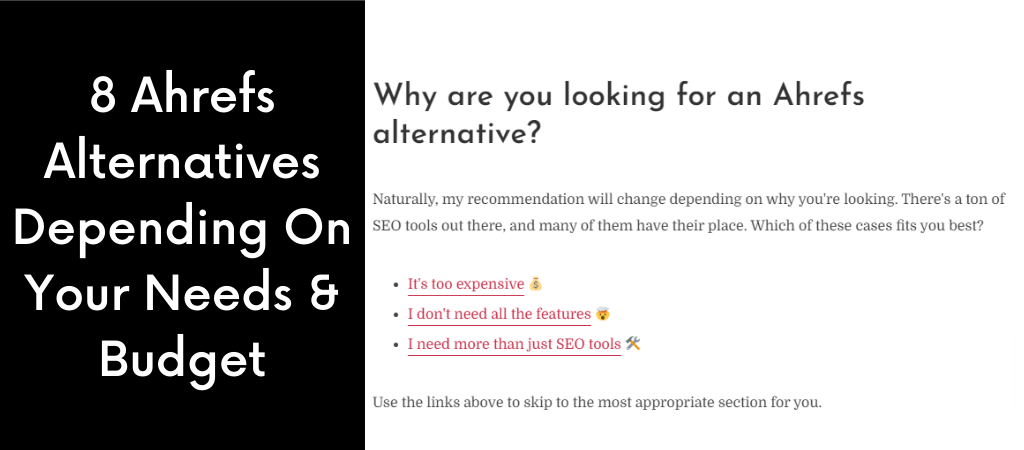
2. Alternatives à Trello par ClickUp
En tant qu'outil dans l'espace de productivité, ClickUp est une alternative à Trello. Il est donc logique qu'ils veuillent avoir la possibilité de se présenter comme tels.
Voir l'article complet, ClickUp identifie les inconvénients de Trello, ainsi que ce que vous devriez rechercher dans une alternative. Avant, naturellement, de se présenter comme l'alternative #1 :
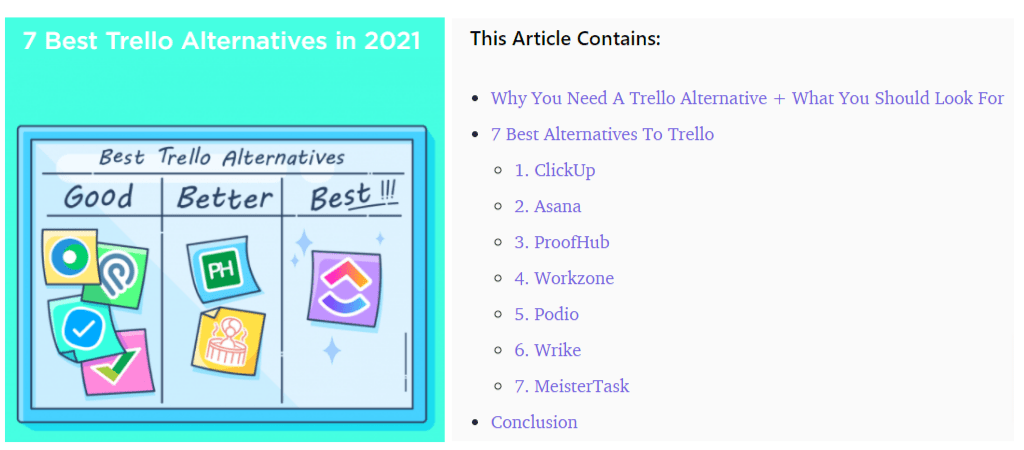
3. Hotjar Alternatives par CrazyEgg
A l'instar de l'article de ClickUp ci-dessus, CrazyEgg se présente ici comme une alternative à Hotjar.
Ils commencent par classer les outils, car Hotjar possède plusieurs fonctions. Certains outils peuvent remplacer une fonctionnalité de Hotjar, mais pas d'autres (par exemple, les cartes thermiques, mais pas les tests a/b).
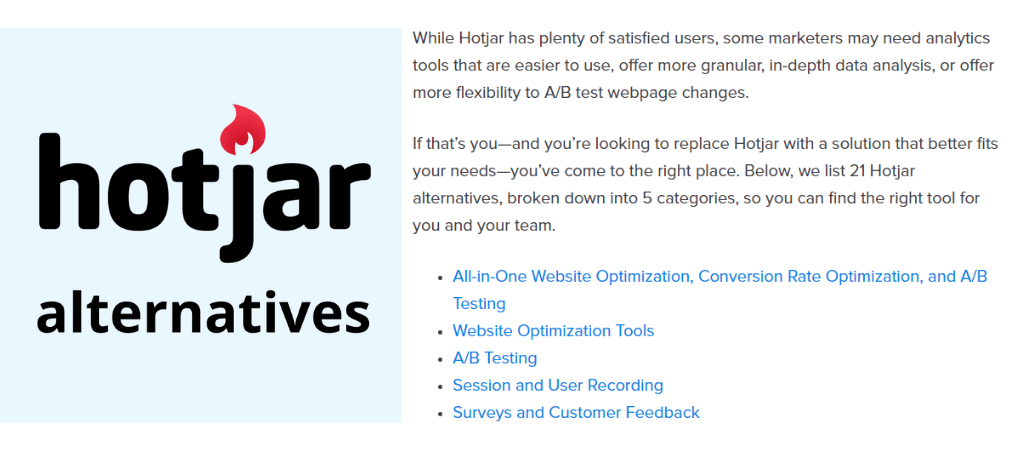
Ensuite, ils énumèrent chaque outil avec des puces et un bref résumé. C'est simple, mais efficace.
Produit physique Listicles alternatifs
1. Rolex Explorer Alternatives par Watch & Bullion
Ici, les alternatives sont classées en fonction de leur accessibilité financière :

6 alternatives ont été identifiées, principalement sur la base de leur apparence. La majorité des personnes qui liront cet article seront celles qui aiment l'aspect de l'Explorer, mais qui ne peuvent pas se permettre son prix de $6.5k+.
La répartition des produits en trois catégories - budget, milieu de gamme et haut de gamme - permet au lecteur de passer rapidement à la solution qui lui convient le mieux.
2. Alternatives à l'iPad par MyNextTablet
Cet article reconnaît que d'autres tablettes sur le marché sont meilleures que l'iPad à certains égards, mais pas à d'autres :
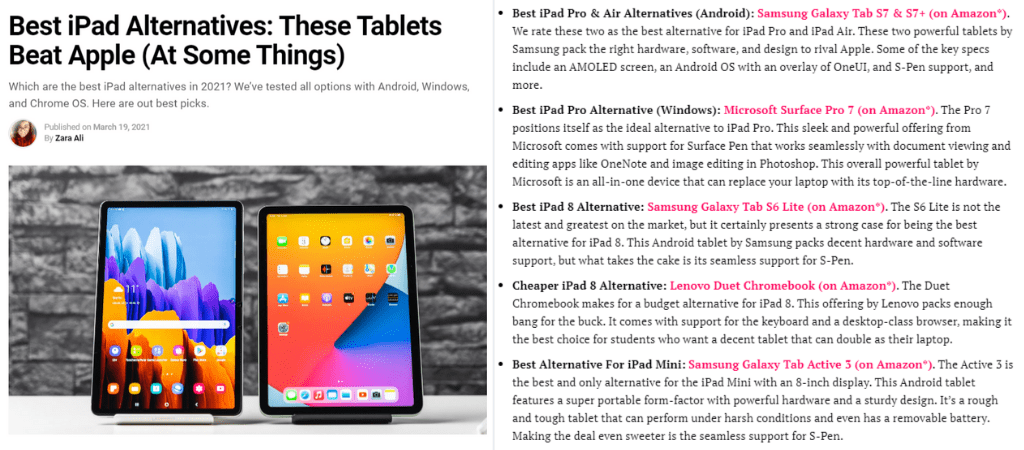
C'est un bon exemple de la manière dont il faut aborder les recherches plus générales. Il existe une multitude d'iPads différents, et vos suggestions doivent donc dépendre du modèle spécifique envisagé par le lecteur.
Ils identifient des alternatives pour différents modèles tels que l'iPad Pro ou l'iPad mini, et ajoutent des suggestions supplémentaires telles que des alternatives moins chères.
3. Benchmade Bugout alternatives par Knives Advisor
Cet article sur les alternatives est similaire à l'exemple de Rolex, dans la mesure où Benchmade est une marque haut de gamme. Les amateurs qui souhaiteraient acheter un couteau Benchmade ne pourront peut-être pas se le permettre et chercheront des alternatives.

Résumé
Si vous n'avez pas encore expérimenté la rédaction d'articles alternatifs, nous vous encourageons à vérifier les opportunités dans votre niche.
Recherchez ce que les internautes recherchent sur Google, en commençant par les leaders du marché. Ensuite :
- Identifier les points forts du produit.
- Identifier les raisons de chercher une alternative.
- Recommander des produits pour remédier à chaque raison/inconvénient.
En suivant ces étapes, vous donnerez à votre contenu une longueur d'avance sur la concurrence et offrirez à vos lecteurs une expérience exceptionnelle.
Si vous avez aimé cet article, n'oubliez pas de nous suivre sur Facebook, Twitteret LinkedIn! Et n'oubliez pas de vous inscrire dans le boîte ci-dessous.









Laisser un commentaire